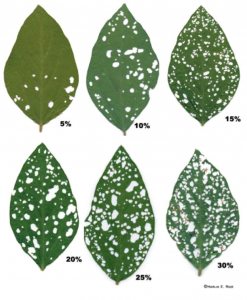Current Soybean Insect Thesholds- Note That Stink Bug Sweep Net Threshold Changed in 2013
go.ncsu.edu/readext?312511
en Español / em Português
El inglés es el idioma de control de esta página. En la medida en que haya algún conflicto entre la traducción al inglés y la traducción, el inglés prevalece.
Al hacer clic en el enlace de traducción se activa un servicio de traducción gratuito para convertir la página al español. Al igual que con cualquier traducción por Internet, la conversión no es sensible al contexto y puede que no traduzca el texto en su significado original. NC State Extension no garantiza la exactitud del texto traducido. Por favor, tenga en cuenta que algunas aplicaciones y/o servicios pueden no funcionar como se espera cuando se traducen.
Português
Inglês é o idioma de controle desta página. Na medida que haja algum conflito entre o texto original em Inglês e a tradução, o Inglês prevalece.
Ao clicar no link de tradução, um serviço gratuito de tradução será ativado para converter a página para o Português. Como em qualquer tradução pela internet, a conversão não é sensivel ao contexto e pode não ocorrer a tradução para o significado orginal. O serviço de Extensão da Carolina do Norte (NC State Extension) não garante a exatidão do texto traduzido. Por favor, observe que algumas funções ou serviços podem não funcionar como esperado após a tradução.
English
English is the controlling language of this page. To the extent there is any conflict between the English text and the translation, English controls.
Clicking on the translation link activates a free translation service to convert the page to Spanish. As with any Internet translation, the conversion is not context-sensitive and may not translate the text to its original meaning. NC State Extension does not guarantee the accuracy of the translated text. Please note that some applications and/or services may not function as expected when translated.
Collapse ▲I’ve been getting a lot of questions on soybean insect thresholds. These were covered in a blog article three weeks ago, but I hope this article is a bit more specific. Note that our stink bug threshold was raised from 2-3 stink bugs/15 sweeps (one sweep = one “swoosh” of the net) to 5 stink bugs/15 sweeps in 2013. This was covered in a recorded presentation, many county meetings and previous blog articles. Here are the thresholds:
Defoliators: 15% during the reproductive stages and 30% pre-bloom. These include armyworms, bean leaf beetle, green cloverworm, loopers, etc. Be sure to estimate defoliation throughout the entire canopy, not just on the top visible leaves. Loopers tend to defoliate from the bottom up.
Corn earworm/tobacco budworm: The threshold varies with insecticide choice, price of beans, sampling method and row spacing. I suggest using the earworm/budworm online threshold calculator as a guide for treatment. This calculator has been updated. For example, the threshold does not change when the price of beans exceeds $10/bu.
Stink bugs: Stink bug online threshold calculator.
Kudzu bug: 5 per plant for seedling beans and 1 nymph per sweep (one sweep = one “swoosh” of the net) during and after July.



